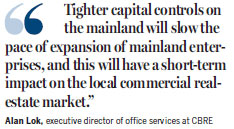Office-rental market loses shine as mainland tightens controls
Updated: 2017-01-24 07:32
By Lin Wenjiein Hong Kong(HK Edition)
|
|||||||||
Hong Kong's overheated office-rental market, which had seen phenomenal growth in the past few years amid an influx of key financial institutions, particularly from the mainland, cooled significantly in 2016 as demand from multi-national enterprises slackened, coupled with limited available of space in the city's prime commercial districts.
Pundits also expect the cooling trend to persist this year, with the office-rental gap between the core and non-core areas to widen.
According to leading commercial real-estate companies, Hong Kong's office-rental market witnessed an overall rent growth of a mild 1.9 percent last year, compared with 8.8-percent growth in 2015.
As a prime location for affluent financial institutions from the mainland, the Central District, including core Central, Admiralty and Sheung Wan, will see continuous growth in office rents. In comparison, companies seeking offices outside Greater Central District may snag a good bargain as office rents in non-central areas are expected to head south this year due to ample supply.

Alan Lok, executive director of office services at CBRE, said office rents in Central are expected to edge up within a 5-percent range this year, which would be the best-performing district in 2017, supported by the low vacancy rate of a stable 1.6 percent and solid leasing demand from mainland companies, but still lower than the 8.7-percent growth recorded in 2016.
He noted that tighter capital controls on the mainland will slow the pace of expansion of mainland enterprises, and this will have a short-term impact on the local commercial real-estate market.
On the other hand, Kowloon East will be the worst-performing district with office rents tipped to drop between 5 and 10 percent, due to higher vacancy levels of 9.8 percent, arising from abundant supply, he said.
Statistics from DTZ/Cushman & Wakefield - a commercial real estate service provider based in the United Kingdom - show that an additional 1.8 million square feet of office space in Kowloon East will come on stream this year, with total supply reaching 2.8 million square feet, the highest annual supply since 2008, compared to total supply of 1.3 million square feet of office space in Hong Kong a year before.
"Mainland financial companies will focus on Central when seeking office space, whilst the cost-conscious multinational companies, as well as those looking to expand or consolidate, will tend to relocate to places outside Central, such as Kowloon East. The oversupply of office buildings in Kowloon East should drive rentals in other areas down in 2017," said John Siu, managing director at DTZ/Cushman& Wakefield.
The firm expects increases of between 2 and 5 percent in overall office rents this year, with the Central district to grow a relatively robust 3 to 6 percent, and Kowloon East to cut back by 2 to 5 percent.
Japanese financial services provider Nomura Holdings has adopted a neutral stance with regard to the performance of Hong Kong's office-rental sector this year, predicting that overall office rents will stay flat on weakening leasing demand, increasing decentralization and rising supply.
"With China's economic growth to stay on a shallower slowdown path, we expect local office leasing demand, despite being thin, to support office rents, buoyed by healthy vacancy," Nomura said.
Citibank, however, seems more pessimistic about the market, with a projection of 5 percent decline in office rents in the Central areas and a 5-10 percent drop in non-Central areas, due to increasing supply and Hong Kong's slower economic growth.
"We've have already started seeing a slowdown in quarterly rental growth. In 2017, we expect Central office rents to peak in the first half due to a decentralization impact driven by excessive supply in Kowloon East, coupled with weak demand amid slow GDP growth," the bank said in its report.
Citibank forecasts that Hong Kong's GDP will grow 1.8 percent and 2.2 percent for 2017 and 2018, respectively, which may affect business expansion plans in Hong Kong and hence the take-up rate of local office space.
There's one district outside Central that may see strong growth in office rents this year - Southern District on Hong Kong Island. The completion of the MTR South Island Line, as well as the comparably low rental costs, are likely to boost demand in the district.
"We have seen customers looking for office space in Southern District before the completion of the South Island Line, so we expect office rents there to grow a remarkably 2 to 5 percent this year," said Siu.
Office rents in Hong Kong had risen a modest 1.9 percent last year, with net absorption standing at 368,000 square feet by yearend, equivalent to just 15 percent of the full-year total achieved in 2015.
cherrylin@chinadailyhk.com
|
The prime Central business district on Hong Kong Island has been a magnet for major mainland financial institutions setting up shop in the city. But, demand from multi-national companies has waned due to limited availability of space in the core office areas, leading to the overheated office-rental market having cooled down in the past year. Edmond Tang / China Daily |
(HK Edition 01/24/2017 page1)
